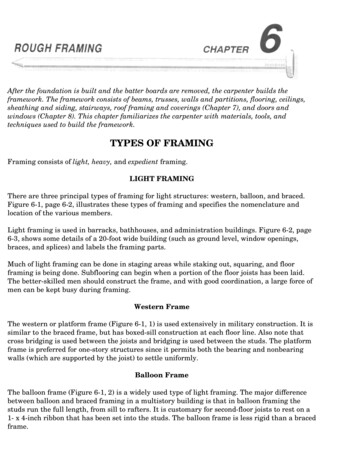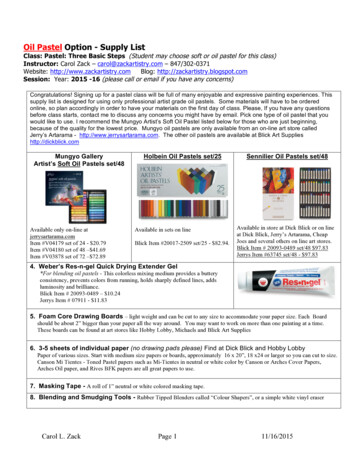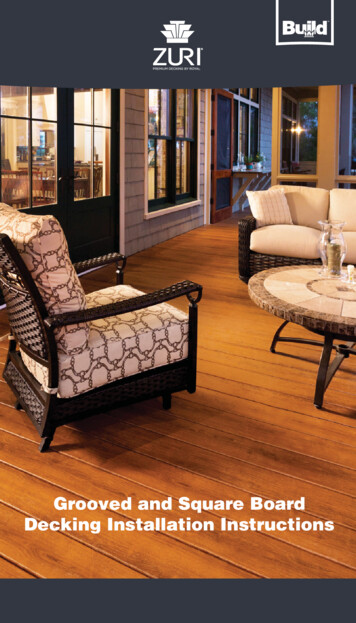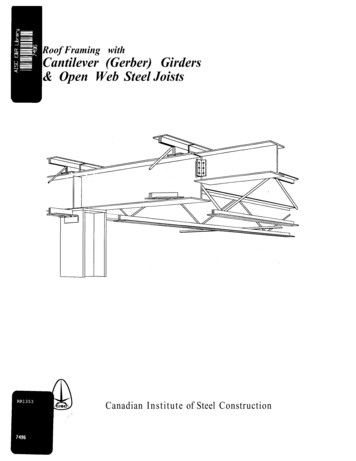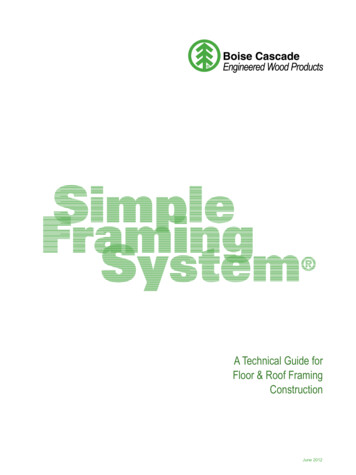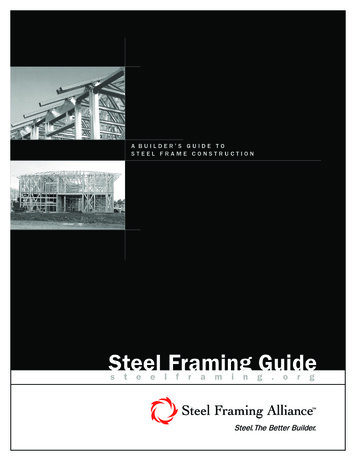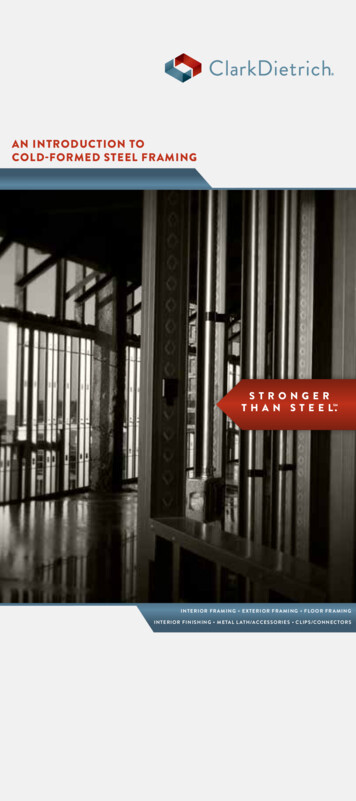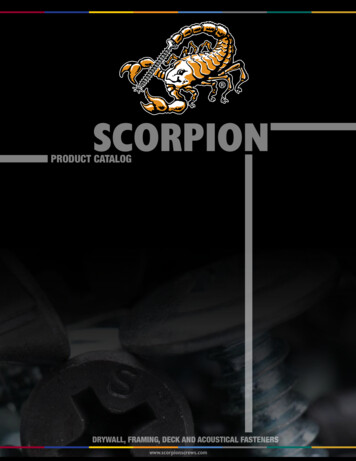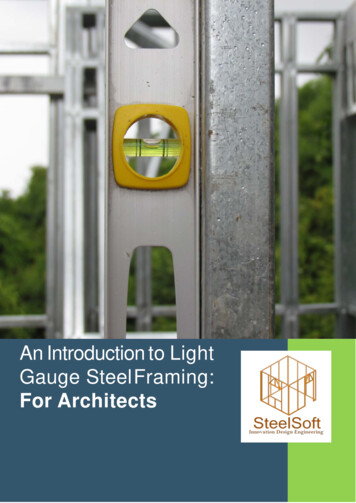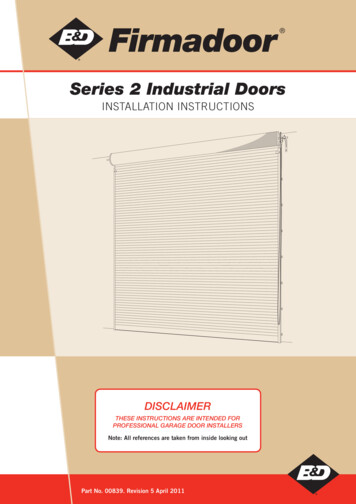
Transcription
tips & ideasPastel Framing TipsHere are some tips on framing pastels that will help you frame yourpastel paintings properly and easily.by Greg FremstadBackingFraming with mats orwithout (matless)Let’s Start with with thematted version first.PastelSecond MatFront MatBackingBackingPastelPastelSecond MatFront MatBackingPastelSecond MatSecond MatFront MatFront MatMats provide airspaceFoam BoardFoam BoardLifterGlassbetween the glass andLifterGlassGlassthe face of the art. TheyGlasspromote air circulationthat prevents mold growthand moisture that bucklesthe art. Mats with astandard bevel as shownin the cross sections inFig 4Fig 3Fig 1Fig 2Figure 1 creates problems.Standard BevelReverse BevelReverse BevelStandard BevelPastel dust that falls offDouble MatDouble MatDouble MatDouble Matthe painting settles onWith LifterWith Lifterthe bevel of the mat(s).You can lessen this situation by lifting the mat(s) up off the painting by inserting strips of mat board or foam boardbehind the mats to make a generous space for the dust to fall into. Make sure the lifters go all the way to theoutside edge of the mats to support the backing. (See Figure 2) The dust will settle on the mat bevels and everytime the frame is jostled the dust will filter down between the mat and the glass.Another good remedy uses “reverse bevel” mat(s) as shown in Figures 3 and 4. The dust will now be urged behindthe bevels. Reverse bevel mats also benefit the art by avoiding that glaring white bevel(s). I’ll bet that very fewpastel paintings need or can stand those stark white accents. A double reverse bevel mat is so much less obtrusivethan those two whitestripes. Two slightlydifferent colors for thefirst and second matswithout the neon whitestripes really looks nice.See the photos at left tocompare the difference.Attaching your paintingwhen mattingFigure 3A. “Reverse Bevel Mats” The artwork should beFigure 1A. Standard “Double Bevel Mats”attached to the backingrather than to the back of the mats. The safest method is to use the clear plastic self adhesive corner pocketsor strips. Available from Lineco in Massachusetts (See Figure 5 on next page), they are similar to the little blacktriangle corners used in old photo albums. Although these cover a bit of the art they are clear and do not actuallyattach to the art so they are archival. (Archival in this sense means reversible without damage to the art).1
tips & ideasThe down side is if the frame is dropped the art may be damaged bythe small corner engagement. Long strips along the bottom of theart will help in this regard. You can make your own corner pockets orstrips by folding thin neutral pH rag paper (like good stationery) andattaching those to the backing with either glue or tape. See Figure5-A. Make sure to leave a little wiggle room to allow for expansionfrom changes in humidity.PastelTapeTightly folded rag paperTapePastelPastelPastelClear Polyester SelfAdhesive Mounting StripsClear Polyester Self AdhesiveMounting CornersFor large or heavyPastelPastelpieces I recommendusing wet-torn Japanesehinge papers andcooked wheat starchFigure 5. Pastel Corner StripsFig 5paste. (See Figure6 below) Wheat starch paste does not degrade with age and iseasily reversible with a slightly dampened Q-tip – even aftermany years. Experienced paper conservators, museum curators,and even quality framers use this method. You should attach theprimary hinges to the top of the art so that it hangs in suspension.Gravity will help keep the art flat. Loose “safety hinges” shouldalso be attached to the bottom to keep the primary hinges fromWet-Torn Japaanese hinging paperFigure 5-A. Paper Mounting Strips“peeling” off if the art is turned sideways or up-sidedown. The hinges should be the weak link in yourassembly. You will want the hinges to tear before theart tears. Linen hinge tape (either pressure sensitiveadhesive or the gummed style) is way too strong tobe the weak link. These tapes are not considered“Archival” as they are very difficult to remove from theart without damaging the art. Check out the article onhinging tips and ideas at FrameTek.comletsaP)ediS kcaB(Pasted AreaOne “T”-Hingenext to pasteladhered to backingPastel(Front side)2nd “T”-Hingespaced awayfrom edge ofpastel adheredto backingNext best would be gummed Hayaku hinging tapeavailable from Lineco in MA. It is important to wait aFigure 6. Hinging pastel for mattingbit from the time you wet it until you apply it to yourart as too much moisture will pucker your art. If you wait too long, you won’t get a strong bond. Practice bywetting up 8 small hinges all at once and applying them to a piece of bond paper one at a time every 2 minutes.Use an egg timer as you will probably get distracted. This will show you how long you must wait from the timeyou wet the hinges until you apply them to your art. The first ones will be too wet, the last ones will be too dry.This timing is very critical. Don’t press hard on wet hinges as the moisture will pucker your art.There are virtually no self adhesive tapes on the market that could be considered “archival” (regardless of theclaims on the packaging) because they are not reversible without damage to the art. Reversal of pressure sensitiveadhesives generally requires solvents that are very likely to damage your fragile pastels. Also, the term “acid free”is nothing more than a marketing term to sell you more expensive stuff. To be either acidic or alkaline (read pHvalues here) it must be dissolvable in water. Plastic tapes with pressure sensitive adhesive are not dissolvable inwater, and thereby cannot be either acidic or alkaline. They are still not suitable for attaching art to the backing.2
tips & ideasMatless framingPastels on either paper or board, must have some aircirculation between the art and the glass to prevent moldgrowth and maintain a constant humidity level across theentire face of the painting. Mold doesn’t like air circulation.If the glass is right up against the art, humidity changes willaffect the edges of the art long before it works its way to thecentral area. As the paper swells or shrinks due to changesin humidity, it will cause buckling starting around the edges.FrameSpace PastelGlassBackingTapeEconoSpace PastelGlassBackingWith mattless pastel framing, you will need to incorporatespacers to keep the glass off of the art. You can makeyour own spacers from strips of mat board or foam boardhowever it is much easier to use pre-manufactured spacers.TapeSome are solid plastic, some are hollow plastic, and oneFigure 7. Cross section of FrameSpace and EconoSpace.called FrameSpace is an “S” shaped plastic. If you cancontrol the exact size, thickness, and squareness of the glassand the size of the frame, Framespace is the way to go. FrameSpace adds about 1/16-inch to the length andwidth of the glass but if the glass is square and there is room in the frame it is by far the easiest to use.See Figure 7.FrameSpace is mechanically permanent, it will never sag orcome loose and it keeps the glass from shaving bits of paint, goldleaf, and wood off the frame. It is also easily removed to clean orreplace the glass.FrameSpace cuts easily with garden shears called “anvil pruners”(rose trimmers) or a sharp razor blade. (See Figure 8 at left) Watch ademo video about FrameSpace here: www.frametek.comFigure 8. Anvil Pruners (rose trimmers)The EconoSpace comes in 4 sizes from1/16- to 3/8-inch airspace and full 60 inchlengths. Most pastel artists use the 1/8inch EconoSpace as it provides the sameairspace as a double mat. EconoSpace alsohas a satin finish on one side and is availablein clear, black, and white.EconoSpace is hollow and, therefore, muchlighter than the solid ones and is stiffer than ifit were made solid out of the same material.This is important because gravity is alwayssucking on that top piece in the frame tryingto make it sag. EconoSpace also cuts easilywith garden shears called “anvil pruners”(rose trimmers) (See Figure 8 above) or a sharprazor blade. EconoSpace is very forgivingabout glass thickness, size, and squareness.Of the rectangular shaped plastic spacers with the pressuresensitive adhesive, only the EconoSpace (See Figure 7 above)brand has a 5 mil (5 thousands inch) thick adhesive. All the rest onthe market have a 1 or 2 mil adhesive.A word here about the method offraming pastels directly against the glassand taping all around holding it alltogether. Great! Cheap, easy, fast. Theproblem is mold growth, paper bucklingand pastel adhesion to the glass. Weold framers can tell you hundreds ofhorror stories about this method. Justbecause it’s been done for years doesn’tmean it’s right or proper.3
tips & ideasAttaching your pastel when matless framingFor most small pieces painted on fairly stiff paper, under 18” x 24” or so, attaching the art to the backing isunnecessary. On larger pieces if the art is just resting on the bottom rail of the frame, it may “belly out” near thebottom with time and gravity so you may want to hinge the art over the top of the backing so that gravity will helpkeep it flat.Bonding the paper to a substrate is not recommended for archival purposes because it is not reversible. The artcannot be saved if the substrate bows or get degraded by moisture. Spray adhesives are not at all permanentand are weakened by heat and humidity. Water based glues are often the cause of substrate bowing. When youmake an un-equal lamination (like bonding something to only one side of a board) the opposite side will absorbmoisture and swell slightly causing bowing.Double backed tapeSuppose you stick a piece of paper art down to a board with double backed tape (like ATG tape) in two placesat the top. When the art expands or contracts with changes in humidity, the art will buckle between the spots oftape. In fact, you will probably be able to see exactly where the tape pieces are right away. It will get worse. Seethe article on hinging at FrameTek.com.A bit about glassRegular Single Strength Window Glass (nominally 3/32-inch thick) is the glass most framers use. It is alsoavailable from hardware stores like Home Depot, Lowes, as well as your corner glass shop. Tru-Vue makesseveral “speciality” glasses that have UV filtration, reflection control, and other features.If you buy glass from a frame shop, they will mark it up (as they have to) but it’s the same glass from the samefactories that is available to you elsewhere without the markup.Don’t get sucked in by UV filtering marketing. Read it carefully! Regular glass filters out about 45% of UV. The“museum” type glasses filter out over 97% of UV. However, the visible part of the light spectrum (red, blue,green) will still fade artwork. I have tested UV filtering glass and acrylic against regular window glass and thefading was just about the same. If you can afford it, sure, the UV protection is better but still don’t hang ANY artin bright lighting. It will still fade! (That’s why museums are kept so dark).“Non glare” glass is the type with an etched (frosty) surface on one or both sides, spaced away from your pastelwith either mats or spacers will result in a fuzzy look. Some pastel artists like this look.“Anti-Reflection” or “reflection control” glass. (There are several tradenames referring to this coated glass.)This stuff is amazing. You just can’t see the glass and reflections seem to go away. The down side: It’s reallyexpensive and hard to clean. Especially fingerprints. And everyone will touch it because they can’t believe thatthere’s glass on it. If you can’t handle the reflection that comes with regular glass, move a little to one side or theother.There is a new anti-reflection glass made by Gro-Glass called “ArtGlass” that is “water white” (no green tint) andis much easier to clean and doesn’t show fingerprints. They also offer UV blocking versions.Framing pastels with acrylicSome shows require that your pastels be framed with acrylic for entry. There are some tricks you can use to makethis work.First, I recommend cleaning the acrylic with a very soft cloth (no paper towels as they are too abrasive) and acleaning/polishing/anti-static product available wherever you bought your acrylic. A couple of the brand namesI’ve used are “Brillianize ” and “Novus ” but there are several others.4
tips & ideasWhen cleaning the acrylic, try not to rub briskly as you will create static. The fluid needs to be applied to get theanti-static effect, so take your time and rub slowly. Treat both sides of the acrylic sheet.When framing either with mats or mattless, you‘ll want to insure that the acrylic is held as far away from thesurface of your art as far as possible in the frame you’ve chosen. This will decrease the affect the static will haveon attracting loose pastel dust.There is a free article on framing with acrylic at FrameTek.comBe cautious when buying acrylic glazing from some internet frame suppliers as they usually sell rather thin sheetsthat will bow if your frames are large. Stick with the 1/8-inch thick stuff (3mm). Make sure that you are gettingacrylic and not styrene as styrene scratches very easily.Tape sealingTape sealing your glass-art-backing package isvery important.By tape sealing I mean applying tape to stopthe flow of air (dust and critters) in or out ofthe frame. The tape should cover about 1/16inch of the front of the glass and reach roundto the back of the backing. The tape shouldgo all around all four sides of the frame andseal it completely. This will prevent any rapidchanges in humidity inside the frame cavity.See Figure 9 for a typical tape sealing method.FrameSpace PastelGlassBackingEconoSpace PastelTapeTapeMat(s)PastelGlassBackingTapeThe tape will also capture any fresh glass chipsas well as dust coming from the edge of matFigure 9. Tape Sealingboards or foam boards. Once the package issealed, you’ll probably never have to open the frame to chase dust. Most framers use 3M’s #810 “Magic Tape ”as it is available in 3/4 or 1 inch wide by 36 or 72 yard rolls from office supply stores. This tape is “Acid Free” ifyou like that term.You’ll find a great article on tape sealing titled “Stop The Dust Pump” atFrameTek.com.Fitting the art in the frameFitting is the term framers use to describesecuring the glass-art-backing package into theframe.There are several tools used for this: pointdrivers, brad pushers, framers pliers and even ascrewdriver.Figure 10. Point DriverPoint drivers can impact the frame so much thatthey shake pastel dust onto the glass if used as shown in the instructions. Thebetter way to use point drivers is to stand the frame up on edge on a table andshoot the points down towards the table. The mass of the table will absorb theimpact. See Figures 10 and 10A.Figure 10A. Shoot the points down towardsthe table to avoid shaking pastel dust off thepainting.5
tips & ideasBrad pushers push brads (a slightly headed nail) into the inside of the frame rabbet. These are several available onthe internet for under 10. They work well if you have the strength. Put the frame up against the backsplash ofyour kitchen counter or wall baseboard so that you don’t have to hold the frame so tight when you push the bradsin. See Figure11.BradFramers pliers squeezebrads into the framerabbet with zero impact.They have a goodFigure 11. Brad Pushermechanical advantage soeven weaklings can use them. See Figure 12. You can also seea pair at FrameTek.com.AdjustablePaddedUp to 3-1/2"Figure 12. Framing Pliers“Glaziers points”, Figure 13 below, are clever little metalpointed bits that are pushed into the inside of the frame rabbetwith a screwdriver. They are most commonly used by folkswho replace windows. They also take a bit of strength. Onceagain, pushGlazier’s Pointagainst thesink boardmef frabacksplashokBacor wallbaseboard.BackingSome readymade frames come with “bendy points” alreadyinstalled into the frame rabbet. The theory is that you bend thepoints back out of the way so you can remove the glass andbacking out of the frame. Then, when you install your glassFigure 13. Glazier Pointsart-backing package you “merely” bend the points back downover your art. But wait! Your glass-art-backing package isthicker than what you took out of the frame. You can carefully make this happen but try not to put ANY pressureon the backing. Caution – these points are very sharp. Try not to bleed on your pastel.Fig 14It is VERY IMPORTANT that whatever means you use to secure the art in the frame that you don’t put ANYpressure on the backing while fitting.Your art WILL expand and contract with changes in humidity. If you apply ANY pressure on the backing, you willpinch the art all around the edges. Now, when it expands and contracts, it has no place to go so it will buckle.When you have finished fitting your frame you should be able to slide a business card between the lip of theframe and the glass. This will insure the free expansion/contraction of all the materials in the frame.Turn buttonsTurn buttons come on some readymade frames. These are small metal or plastic tabs that are fastened to theback of the frame and rotate over the backing to hold everything forward in the frame. These will work or notdepending on the total thickness of your glass-art-backing package and the depth of the frame. If it all works outthey are pretty handy for changing art out in your frame easily.Other readymade frames come with turn buttons attached to a hardboard backing. These tabs rotate and their tipsfit into a slot milled into the inside of the frame rabbet. This will work only if your glass-art-backing package is thesame thickness the slot is designed to accept.6
tips & ideasIf your glass-art-backing package protrudes out past the back of the frame you have several options. There areoffset clips that you screw to the back of the frame. These hold everything forward in the frame. Doing a paperdust cover over these comes out looking way less than professional. Leaving them uncovered even looks worse.You can screw/bond narrow wood strips to the back of the frame to extend the depth of the rabbet. Your points orbrads will then be pushed into these strips. Put a paper dust cover over the back as if it were just a regular frameback.1/8” RabbetSpace 1/4”3/8”Figure 14. RabbettSpace cross-sections.1/2”Then there is RabbetSpace RabbetSpace is an extruded black plastic strip thatyou screw to the back of the frame. (See Figure14). Itcomes in four sizes from 1/8-inch offset up to 1/2-inchoffset. This looks the most professional if it is miteredat the corners. You can see more at FrameTek.com.If you frame with metal frames do not use the springclips that come with the frames. Yes, they’re easy andfast, but they apply way too much pressure to allowfor the free expansion/contraction of the art.Better is to glue 3/8-inch wide strips of mat board,foam board, etc. to the back of your backing toALMOST fill the space in the frame.Dust coversDust covers generally apply to the paper backing that custom frame shops attach to the back of the frame. As thename implies, it’s to keep dust (and critters) from getting into the frame cavity. Since you are now a “tape sealer”,a dust cover is only needed to hide your fitting points and make the back of the frame professional looking.Taping across the gap between the frame and the backing is a terrible idea. Any pressure sensitive tape you wouldthink about using will not last long and as the tape either dries out or gets gooey it will probably leave marks onyour wall. Acids migrating out of the wood adversely affect pressure sensitive adhesives. Although most framersuse ATG tape to apply dust covers they often come loose because of this. White glue is better for this.Apply a small bead of glue, smoosh it smooth with your finger tip and wait until it tacks up a bit before you applythe paper as it will pucker if the glue is too wet.“Bumpons ” and felt padsIt’s always a good idea to place a couple of 3M’s “Bumpons ” or felt pads at the bottom corners of the frame.These provide additional air circulation to the back of the frame and prevent dust from settling on the juncturebetween the frame back and the wall. They also help keep the frame from swinging out of level.HangersYou’re on your own here. There are hundreds of different hangers available. Shy away from single “Saw Tooth”hangers on narrow frames as gravity will bow the top frame rail in time. They never stay level either. Two sawtooth hangers near the corners would be much better.If your hanging system includes wire, rather than using screw eyes, go for the D-Ring style wire anchors as theywon’t tend to pull out as easily and will stay closer to the wall. If possible, rig the wire for 2 wall hooks with thewire rigged to go almost straight up from the D-rings.7
tips & ideasThis puts the least amount of strain on both the wire and the frame. It will always stay level too.60 45 30 15 bs.19 L10 5 19 Lbs.2 For every 10 Lbs. of picture, these are theforces pulling on each wire anchor point:60 45 30 15 6 Lbs.7 Lbs.10 Lbs.19 Lbs.10 29 Lbs.5 57 Lbs.2 143 Lbs.Force 1/2 WeightSine of Angle10 Lb.FrameFigure 15. Picture hanging wire/weight placementSo now a little re-cap Always provide airspace between the glass and the art with either mats or spacers. Use “reverse bevel mats when possible. When “mattless” framing with smaller pastels done on paper do not attach them to the backing. On larger pastels done on paper, it is best to use wet-torn Japanese hinging papers and cookedwheat starch paste. Don’t bond your pastel to any backing. It is not archival as it is not removable. Don’t use ANY pressure sensitive tapes to attach your pastels. They are temporary and not considered archival. Tape-Seal your glass-art-backing package before it goes in the frame. Don’t put ANY pressure on the back of your backing when fitting your frames. Use “Bumpons ” or felt pads on the bottom corners or your frames. Hang your frames on two hooks whenever possible.8
Figure 5. Pastel Corner StripsFig 5 Figure 5-A. Paper Mounting Strips el el el Tightly folded rag paper Tape Tape Figure 6. Hinging pastel for matting el ide) el ont side) Pasted Area One "T"-Hinge next to pastel adhered to backing 2nd "T"-Hinge spaced away from edge of pastel adhered to backing Wet-Torn Japaanese hinging paper
